PRESENTATION: Eddie Rodolfo Aparicio-Focus
 Eddie Rodolfo Aparicio examines local histories of materials linked to pre-Hispanic cultures in Central America, particularly his family’s homeland of El Salvador. Tracing the cultural and technological knowledge embedded in historical uses of rubber, amber, and clay, his work lingers on materials that rely on non-western technological inventions that are mined by corporations today. Many of the materials Aparicio employs are organic or found, and his work underscores inextricable links between environmental and social justice.
Eddie Rodolfo Aparicio examines local histories of materials linked to pre-Hispanic cultures in Central America, particularly his family’s homeland of El Salvador. Tracing the cultural and technological knowledge embedded in historical uses of rubber, amber, and clay, his work lingers on materials that rely on non-western technological inventions that are mined by corporations today. Many of the materials Aparicio employs are organic or found, and his work underscores inextricable links between environmental and social justice.
By Efi Michalarou
Photo: MOCA Archive
“Focus: Eddie Rodolfo Aparicio” is the first solo museum exhibition for Los Angeles–based artist Eddie Rodolfo Aparicio the exhibition explores Aparicio’s engagements with the Salvadoran communities in which he was raised, his formal experimentation with natural materials–including rubber, amber, glass, and clay–and his approach to social justice as a form of ecological justice. The exhibition features artworks dating from 2016 to the present and includes the debut of three new sculptures specially commissioned for The Geffen Contemporary. Aparicio debuts three sculptures commissioned by MOCA and installed at The Geffen Contemporary. Among the works of the exhibition are: “City Bus Memorial (Figueroa St. and Ave. 60, Los Angeles, CA)” (2016) this work is among Aparicio’s earliest “Caucho” pieces. Its height was determined by the reach of the artist’s arm as he lathered the trunks of two ficus trees with a liquid rubber that dried and congealed before he peeled it off and ultimately pinned the two cylindrical casts to the wall. Textured with car exhaust, staples from flyers, spray-painted graffiti, and other residue adhered to the bark, the rubber impressions serve as a record of the historically Mexican and Central American immigrant community of Highland Park. The trees flanked a bus stop at Figueroa Street and Avenue 60, where a makeshift altar of flowers, candles, and cards memorialized a child killed in a car accident. In casting them, Aparicio situates the trees as witnesses or as living documents that accrue traces of everyday stories often left out of history or forgotten. Referencing Ernesto Cardenal’s 1954 poem about the murder of a revolutionary and subsequent resistance of a nation against tyranny, “Sepultura de semillas (Epitafio para la tumba de Adolfo Báez Bone)” (2021–23) consists of boulders of amber embedded with hundreds of sundry objects Aparicio gathered from Salvadoran communities in Los Angeles and archival documents pertaining to the Central American solidarity movement of the 1980s and 1990s. A previous version of this work was featured in a 2021 exhibition at the Hammer Museum: initially taking the form of a cube, the amber, which was prefossilized rather than cured in the earth over millions of years, slowly deformed over the course of the exhibition, embodying the unfixed nature of memory and the messiness of history. For this exhibition, Aparicio has sealed chunks of the amber in glass, wittily initiating the amber’s fossilization and thereby reforming an archive—eventually, a fossil—of Los Angeles’s Salvadoran diaspora and submitting it to the historical and geological record. Aparicio created the site-specific work “601ft² para El Playon / 601 sq. ft. for El Playon” (2023) by pouring liquid pre- fossilized amber (a resin sourced from trees) onto the floor, where it emulates the shape of El Playon, a vast lava field in El Salvador where President Duarte’s military regime monstrously disposed of the bodies of assassinated civilians during the civil war (1979–92). In its expansive horizontal spread, the work recalls 1970s Process Art while co-opting mapmaking’s gesture of flattening; as decolonialist discourse has argued, maps abstract the earth as territory to be colonized. Aparicio quotes this cartographic logic while reinfusing it with the textures of lived experience: the amber is embedded with found objects, handmade ceramic bones, and facsimiles of documents hailing from the Central American Resource Center (CARECEN), a nonprofit organization that advocates for immigrants’ rights and protests political repression and US military involvement in Central America. The semi-opaque amber simultaneously preserves the alternative archive and disallows total legibility or knowability, thus subverting the map as the “master’s tool”.
A denim pant leg, a T-shirt emblazoned with “THIS IS F*CKED UP,” and a threadbare floral upholstery scrap are among the textiles making up the backing of “La Tecleña (Olympic Blvd. and Burlington Ave., Los Angeles, CA)” (2022). Sourced from thrift shops and found on the street, these fabrics are offered as documentation of Salvadoran neighbor-hoods, along with the cast ficus tree on the face of the work. Painted embellishments—from the freeway off-ramp sign for Staples Center to a distorted LA Dodgers logo and the signage of famed Pico-Union restaurant La Tecleña—further record the cultural life and expression of the city’s Central American diaspora. In this way, Aparicio reconsiders and expands what constitutes an archive, beyond a musty room lined with neatly filed cabinets. Recently, Aparicio has begun to stuff his work with flossy kapok fiber derived from ceiba tree seed pods, transforming it into soft sculpture while introducing a throughline of care, comfort, and craft to his archival practice. “La ceiba me salvó” (2020): the first uses of rubber date to 1600 BC, by the Olmecs, and rubber technology was further developed by the Maya and Aztecs, who created rubber sandals, bands, balls, and medi-cine. The ubiquity of the material today—it is in shoe soles, tires, conveyor belts, and plumbing, and is a linchpin of industrial manufacture—is the result of violent extraction and trade that ensued from Spanish invasion of Central America and European settler colonization. Aparicio initially utilized rubber as an alternative to paint and continues to use it to honor the knowledge and achievements of the ancestors of Latinx communities in the face of the ongoing marginalization and vilification of Central American immigrants. In this work, Aparicio also refers to the ceiba tree—sacred in Mayan civilization, it is an urban transplant to Los Angeles recognizable by its thorns, a natural defense mechanism against parasites. Evoking the ceiba with hand-shaped ceramic thorns, Aparicio points to ecological models of strength and resistance. “El ruido del bosque sin hojas” (2020): Imported and widely cultivated in mid-twentieth-century Los Angeles for their fast growth and broad canopies, ficus trees today are targeted for removal by the city; it is these specifi-cally that Aparicio casts in rubber. Aparicio reimagines the exploited, non-native ficus as a cipher for Central American immigration and has consistently used it as an emblem of the shared heritage of the Salvadoran diaspora. The leaf-like green glass surrounding this work alludes to US-supplied napalm-induced deforestation during the civil war in El Salvador (1979–92). It therefore draws connections between Central America and Los Angeles within a sprawling tale of social and environmental trauma, carried by the currents of mass migration and held within communal memory. The glass also represents catharsis (Aparicio smashed water and wine bottles with family and friends) and safety (it further refers to homemade glass-shard security systems used throughout Latin America).
Photo: Eddie Rodolfo Aparicio, La ceiba me salvó / The Ceiba Saved Me, 2020, cast rubber with ficus tree surface residues on found cloth; glazed stoneware; twine; and wooden support, approx. 122 × 86 × 5 3/4 in. (309.9 × 218.4 × 14.6 cm). Collection of Michael Sherman and Carrie Tivador, image courtesy of the artist and Commonwealth and Council, Los Angeles and Mexico City, © Eddie Rodolfo Aparicio. Photo by Ruben Diaz
Info: Curator: Anna Katz, Assistant Curator: Anastasia Kahn, MOCA (Museum Of Contemporary Art), MOCA Geffen, 52 North Central Avenue, Los Angeles, CA, USA, Duration: 12/11/2023-16/6/2024, Days & Hours: Tue-Wed & Fri 11:00-17:00, Thu 11:00-20:00, Sat-Sun 11:00-18:00, https://www.moca.org/
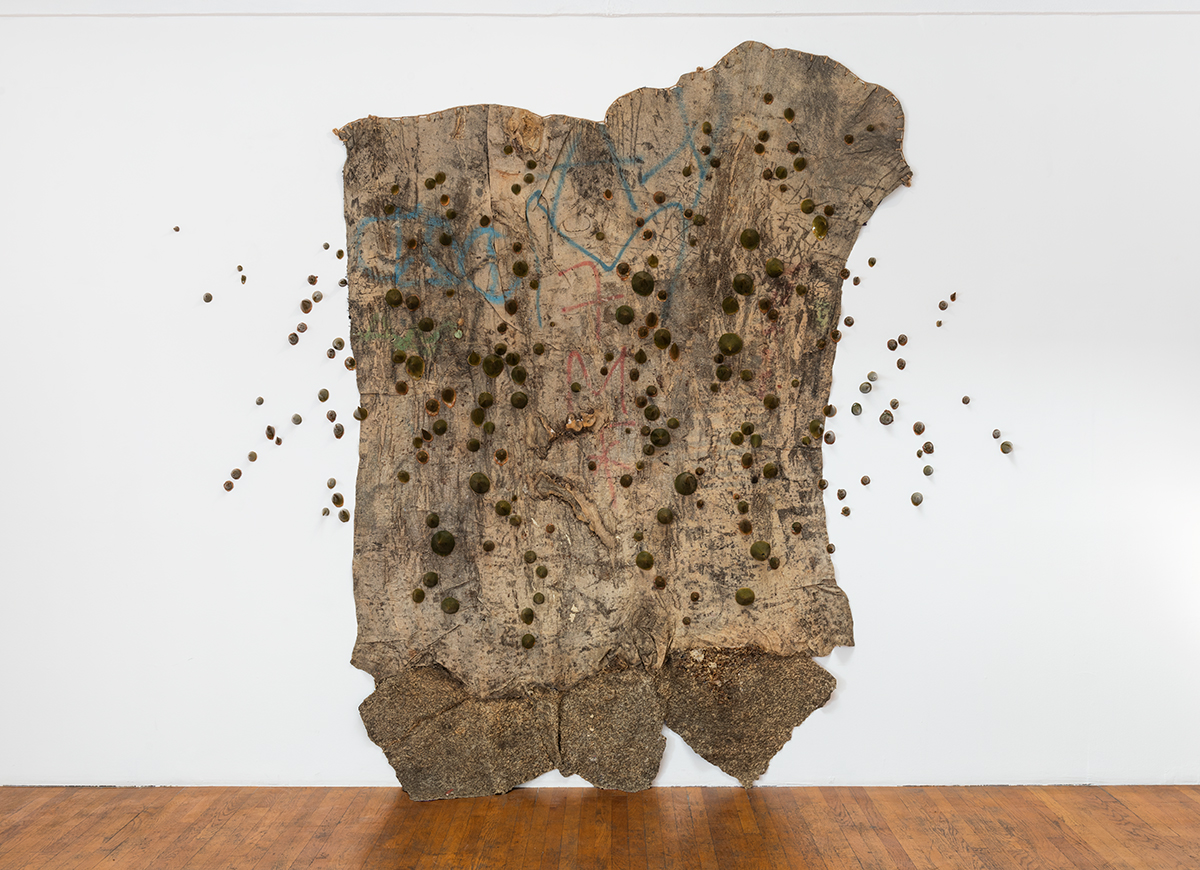
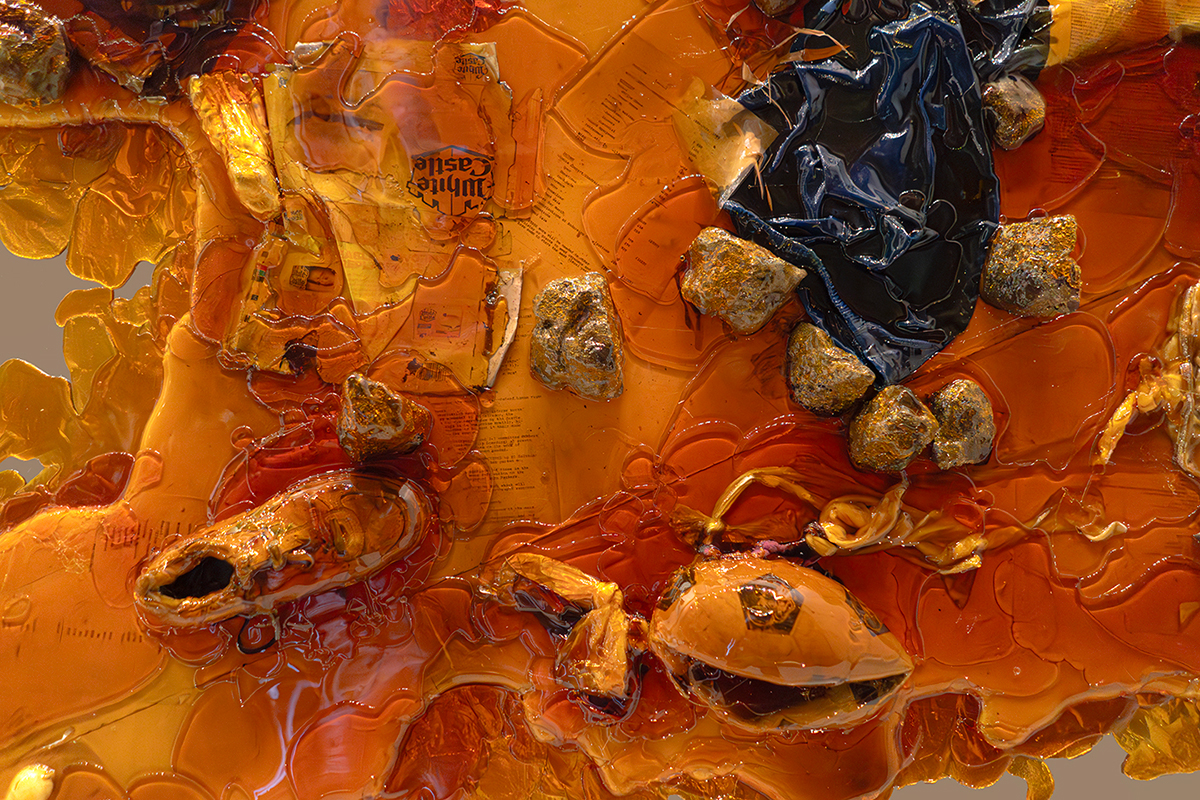
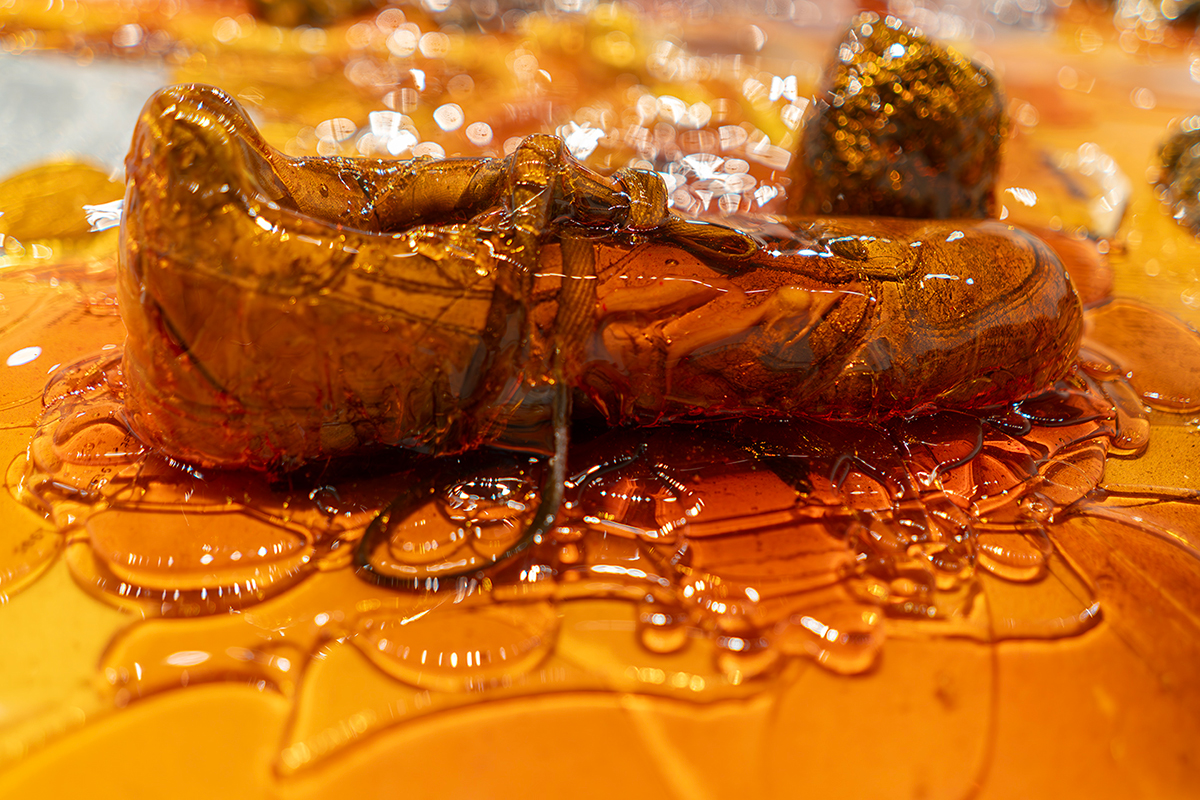
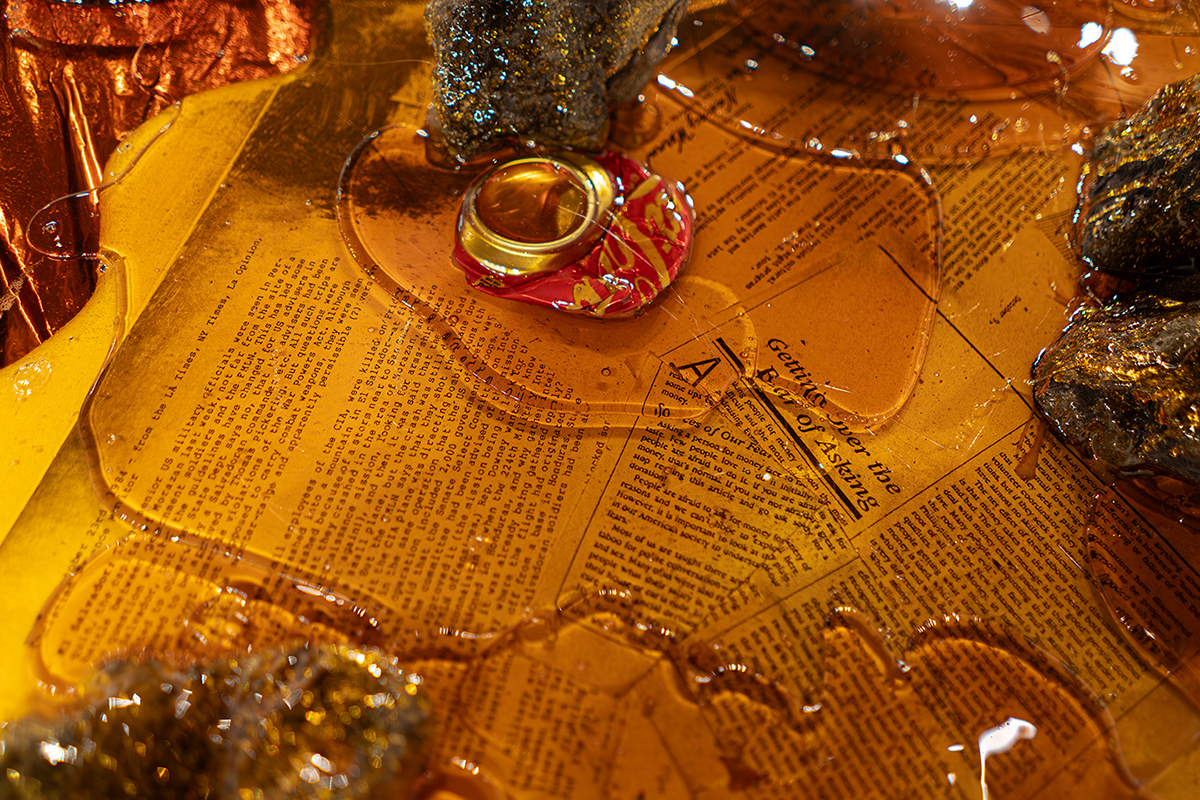
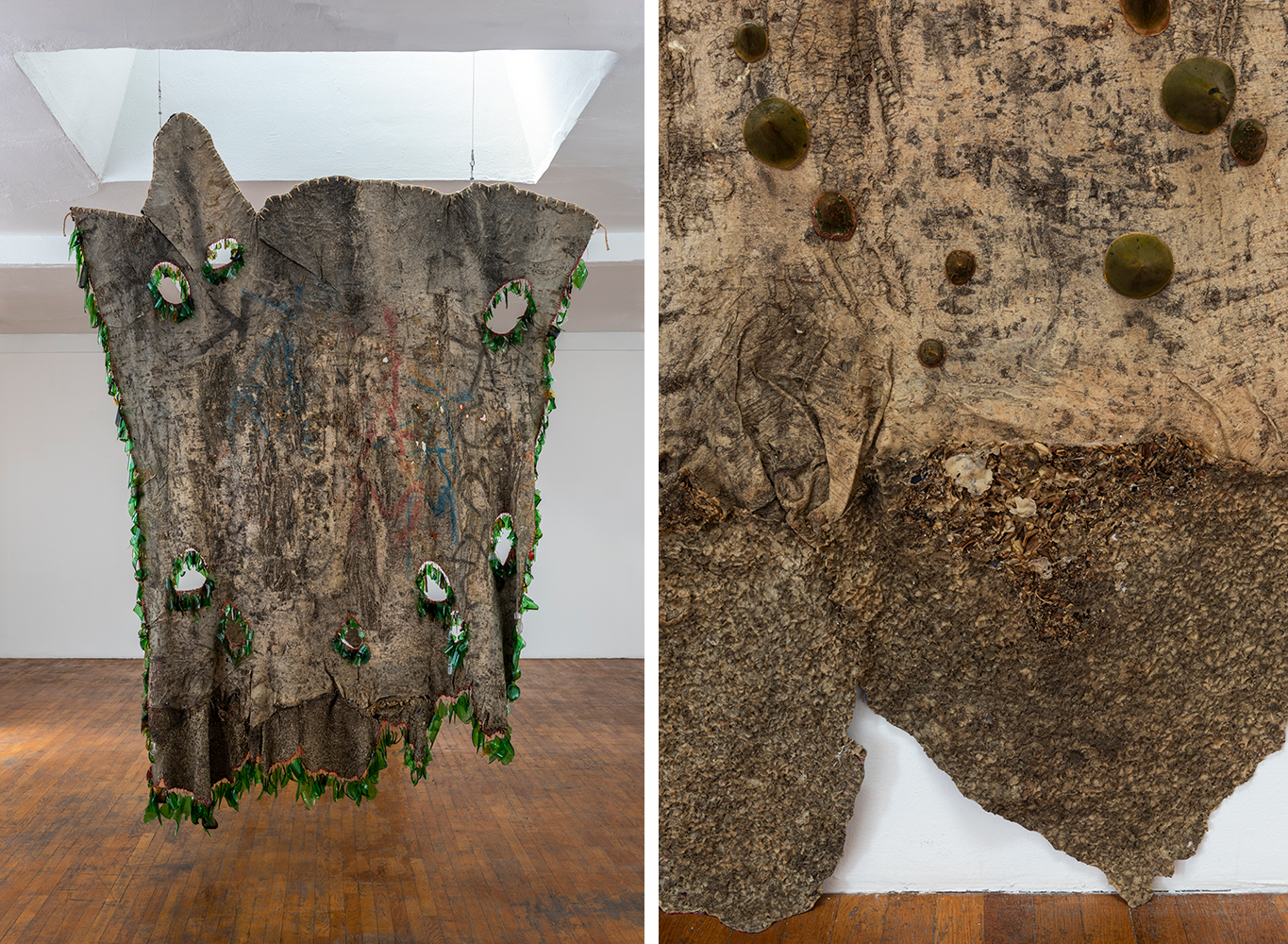
Right: Eddie Rodolfo Aparicio, La ceiba me salvó / The Ceiba Saved Me (detail), 2020, cast rubber with ficus tree surface residues on found cloth; glazed stoneware; twine; and wooden support, approx. 122 × 86 × 5 3/4 in. (309.9 × 218.4 × 14.6 cm). Collection of Michael Sherman and Carrie Tivador, image courtesy of the artist and Commonwealth and Council, Los Angeles and Mexico City, © Eddie Rodolfo Aparicio. Photo by Ruben Diaz
